When designing modular jewelry, you’ll need standardized interface systems that enable seamless component connections without tools. Focus on cultural motif integration to preserve local identity while ensuring material compatibility between metals like stainless steel and brass. Implement geometric adaptation principles for visual harmony and scalable module combinations that offer infinite customization possibilities. Maintain quality craftsmanship standards across all components while utilizing cost-effective production methods that support consumer co-creation opportunities and personalized experiences that transform how people express themselves.
Standardized Interface Systems for Seamless Component Integration
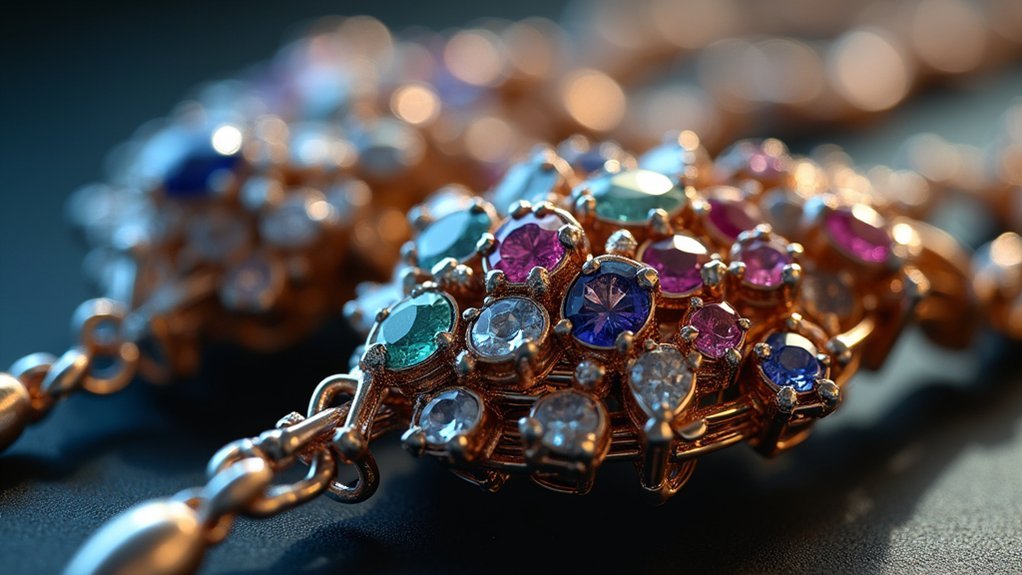
How can jewelry designers create pieces that transform seamlessly from casual daywear to elegant evening accessories?
You’ll need standardized interface systems that enable effortless component integration. These interfaces allow you to connect different modules predictably, guaranteeing smooth assembly without specialized tools. Your modular design approach reduces manufacturing complexity while boosting product reliability through consistent protocols.
Standardized interfaces enable predictable module connections, ensuring seamless assembly while reducing manufacturing complexity and boosting reliability through consistent protocols.
When you implement standardized interfaces, you’re creating diverse customization options that enhance adaptability. Customers can easily modify their pieces for different occasions, increasing consumer engagement considerably.
You’ll find that these systems simplify production costs while delivering unique jewelry experiences. The predictable connection methods guarantee each component works seamlessly with others, giving consumers the freedom to personalize their accessories and create distinctive looks that reflect their individual style preferences.
Tool-Free Assembly and Disassembly Mechanisms
When you’re designing modular jewelry, tool-free assembly mechanisms become the cornerstone of user experience and commercial success.
You’ll need to implement simple yet secure systems like snap-fit designs or screw mechanisms that allow consumers to modify components effortlessly. These mechanisms must balance holding power with ease of disassembly, ensuring your jewelry maintains structural integrity while enabling quick customization.
You’re empowering users to express their individuality through endless combinations of interchangeable elements. This approach streamlines your design process and reduces production costs since fewer base pieces can accommodate multiple variations.
Cultural Motif Integration for Local Identity Expression
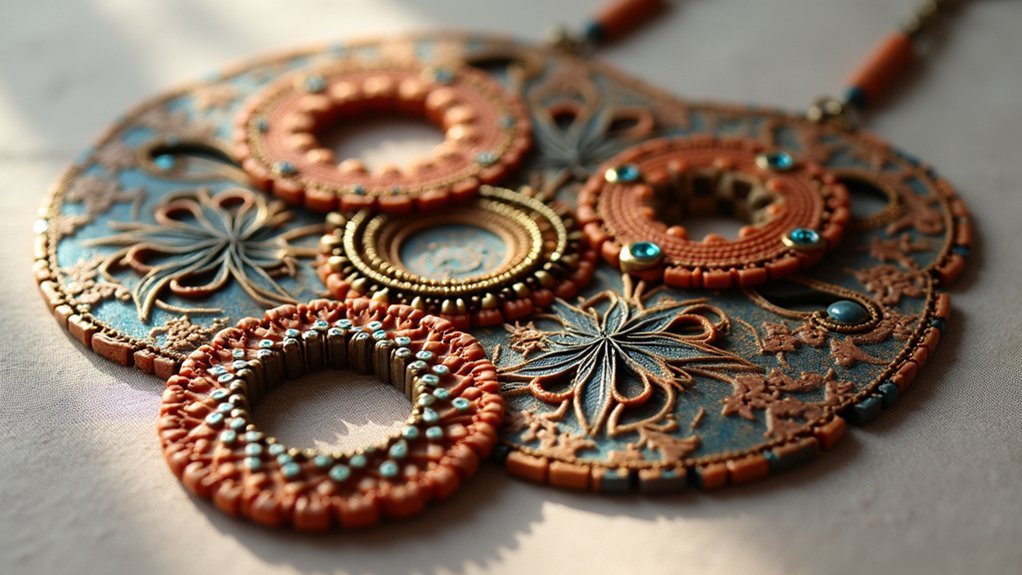
Beyond the mechanical aspects of assembly, modular jewelry design offers you an unprecedented opportunity to weave cultural narratives into wearable art. You can integrate local identity through traditional motifs like batik patterns, creating pieces that celebrate your heritage while maintaining modern functionality.
The Peony Flower and Gajah Oling designs demonstrate how ethnic characteristics seamlessly blend with modular systems, allowing personalization without compromising cultural authenticity.
When you incorporate these meaningful elements, you’re supporting sustainable fashion practices that preserve community craftsmanship. Your modular design approach enables easy adaptation of cultural motifs across various configurations, ensuring each piece reflects local wisdom and significant narratives.
Modular jewelry design preserves cultural heritage while enabling sustainable fashion practices that honor community craftsmanship and traditional narratives.
This integration strengthens the connection between wearer and heritage, transforming jewelry from mere accessories into powerful expressions of identity.
Scalable Module Combinations for Infinite Customization
Since modular jewelry thrives on infinite possibilities, you’ll discover that scalable module combinations transform a single purchase into countless unique pieces. Each module functions as an independent component—charms, links, or decorative elements—that seamlessly attaches and detaches from base pieces.
This modular design empowers you to create personalized styles that adapt to different occasions and moods instantly. The tool-free mechanism eliminates complexity, making customization accessible without technical expertise.
You’ll appreciate how this approach maximizes product diversity while manufacturers reduce inventory costs by offering fewer base pieces that support extensive combinations. This scalable system satisfies your desire for individuality and personal expression, driving stronger consumer engagement.
Modular jewelry’s infinite customization potential guarantees you’re never limited to static designs, fostering lasting loyalty through continuous creative possibilities.
Quality Craftsmanship Standards Across All Components
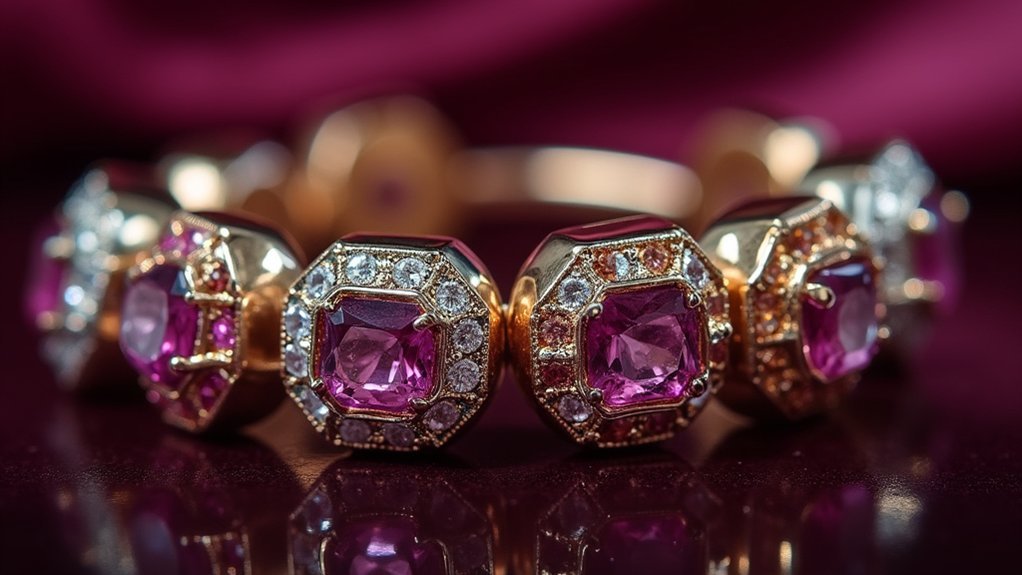
Excellence in modular jewelry demands that every component—from the smallest charm to the primary base piece—upholds identical quality standards. Your modular design benefits from advanced techniques like laser cutting and 3D modeling, ensuring precision across all elements. These standardized interfaces guarantee seamless assembly while maintaining durability and aesthetic criteria.
| Quality Aspect | Implementation |
|---|---|
| Material Standards | Premium metals with consistent finish |
| Cultural Integration | Local motifs authentically represented |
| Technical Precision | Laser-cut standardized interfaces |
| Quality Assurance | Multi-stage inspection protocols |
Quality control processes verify that each component meets your customization options without compromising cultural significance. You’ll find that rigorous craftsmanship standards create modular pieces that deliver both visual appeal and functional reliability, ensuring your investment maintains excellence across every interchangeable element.
User-Centric Design Philosophy for Intuitive Operation
You’ll find that effective modular jewelry systems eliminate the need for tools, allowing you to assemble and modify pieces using only your hands.
Your experience becomes seamless when designers standardize intuitive interfaces across all components, ensuring you can easily connect different elements without confusion.
This approach lets you focus on creativity rather than complex assembly procedures, making customization feel natural and effortless.
Tool-Free Assembly Mechanisms
How simple should jewelry customization be? Tool-free assembly represents the pinnacle of user-centric approach in modular design, where you don’t need any additional equipment to transform your pieces.
Each connection system enables quick, secure attachment through intuitive mechanisms that respond to simple movements like twisting, clicking, or sliding. This simplicity empowers your creativity by removing technical barriers between inspiration and personal expression.
You’ll find that customization becomes effortless when designers prioritize accessibility over complexity. The tool-free mechanism supports sustainability by streamlining manufacturing processes and extending product lifecycles through adaptable configurations.
Modern jewelry design embraces this philosophy because it democratizes creativity—you become the designer, switching elements to match different occasions or moods without requiring specialized knowledge or equipment.
Intuitive Interface Standardization
When standardized interfaces become second nature, your modular jewelry transforms from a collection of separate pieces into an intuitive creative platform.
You’ll discover that effective modular design prioritizes user-friendly mechanisms that eliminate complexity from customization. Visual cues and standardized mechanisms guide you through assembly without requiring tools or expertise, making personalization effortless and accessible.
This intuitive interface philosophy guarantees you can focus on creativity rather than struggling with technical challenges. Each connection point follows consistent design language, enabling seamless user experience across all components.
You’ll find that accessibility drives consumer engagement, as simplified interactions encourage experimentation with different combinations. The standardized approach means once you’ve mastered one connection, you’ve mastered them all, fostering confidence in your ability to create unique jewelry configurations that reflect your personal style.
Material Compatibility and Durability Requirements
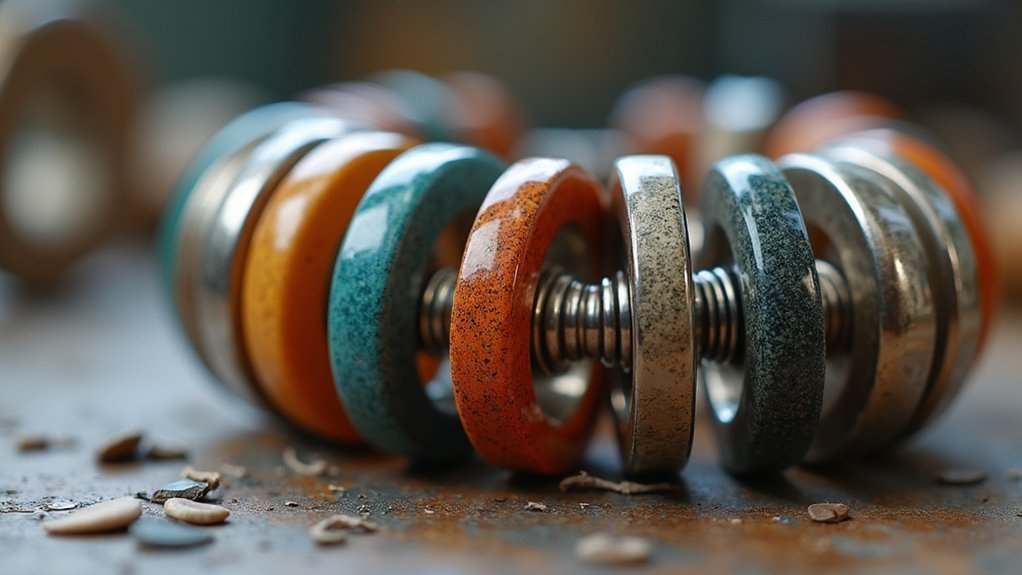
When you’re selecting metal alloys for modular jewelry, you’ll need to prioritize materials like stainless steel and brass that resist corrosion while maintaining structural integrity across multiple assembly cycles.
Your connection points bear the greatest stress during repeated use, so they must withstand constant joining and separation without weakening or deforming.
You can’t overlook how different metals interact at these junction areas, as incompatible materials will lead to galvanic corrosion and premature failure of your modular system.
Metal Alloy Selection
Three fundamental considerations drive successful metal alloy selection in modular design: material compatibility, durability requirements, and cost-effectiveness.
You’ll need to prioritize metal alloys like stainless steel and titanium for their exceptional corrosion resistance and lightweight properties.
Sterling silver, containing 92.5% silver and 7.5% copper, offers aesthetic appeal while maintaining structural integrity for modular connections.
When selecting alloys, you must guarantee compatibility between different materials to prevent tarnishing or component weakening.
Consider engineering hypoallergenic properties for sensitive users without compromising durability.
Your choice directly impacts marketability—precious metals like gold provide luxury appeal but increase production costs considerably compared to affordable alternatives like brass or aluminum.
Balance these factors to create commercially viable modular jewelry that meets both functional and aesthetic requirements.
Connection Point Durability
Connection points represent the most vulnerable elements in modular jewelry systems, requiring meticulous attention to material selection and engineering specifications.
Your modular design’s reliability depends on choosing materials like stainless steel, titanium, or high-quality plastics that guarantee robust connection point durability. These materials must demonstrate compatibility to prevent corrosion and maintain functionality throughout repeated assembly cycles.
Essential durability requirements include:
- Stress testing under tension and torsion conditions
- Wear and tear resistance through multiple assembly/disassembly cycles
- Material compatibility to prevent degradation between different components
- Secure fit maintenance despite repeated use
You’ll need to engineer connection mechanisms that withstand regular use while preserving their structural integrity.
Proper stress testing reveals potential failure points, allowing you to refine your design for maximum robustness and long-term performance.
Geometric Adaptation Principles for Visual Harmony
While traditional jewelry design often relies on fixed forms and static compositions, geometric adaptation principles revolutionize modular jewelry by establishing standardized shapes that seamlessly interconnect across multiple pieces.
You’ll find that symmetrical patterns create balanced aesthetics when combining different components, ensuring visual harmony throughout your collection.
By incorporating traditional motifs like Batik patterns, you’re adding cultural significance while maintaining design continuity.
These geometric frameworks simplify assembly and disassembly processes, making your jewelry incredibly versatile.
You’ll discover expanded customization options as diverse motifs integrate effortlessly within standardized geometric structures.
This approach streamlines production processes while maximizing creative possibilities.
You’re not just purchasing jewelry; you’re investing in endless reconfiguration potential that enhances consumer engagement and personal expression through modular jewelry design.
Cost-Effective Production Methods for Small-Scale Manufacturers
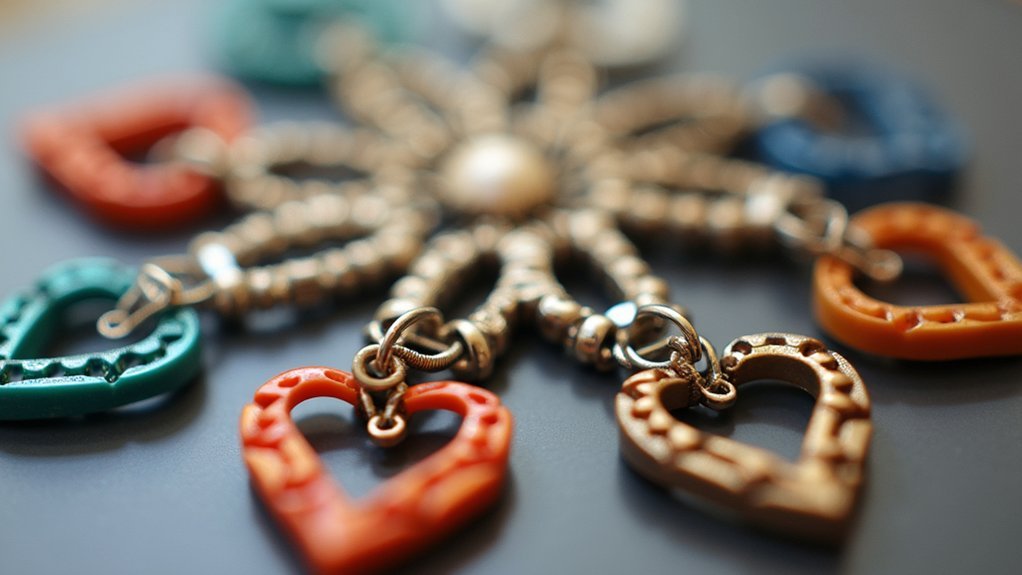
Since modular jewelry design fundamentally changes how you approach manufacturing, you’ll discover that standardized components dramatically reduce your production costs while expanding your product offerings.
Small-scale manufacturers benefit from standardized interfaces that enable efficient assembly and inventory reduction, eliminating the need for extensive stock variations.
Digital platforms transform your 2D concepts into 3D forms without costly tooling investments. You’ll minimize financial risk through rapid prototyping and testing capabilities that allow quick design iterations.
Key cost-effective production advantages include:
- Reduced tooling costs through digital manufacturing processes
- Lower inventory requirements with interchangeable component systems
- Faster market response to emerging trends without overhead increases
- Enhanced customization options that command premium pricing
This modular design approach positions you to adapt swiftly to market trends while maintaining profitability.
Consumer Co-Creation Opportunities for Personalized Experiences
You’ll find that virtual design studio tools transform how customers interact with modular jewelry, letting them experiment with countless combinations before making a purchase.
Through modularity, you’re empowering consumers to express their unique personality by swapping components that reflect their current mood, style, or milestone.
This co-creation approach doesn’t just sell jewelry—it builds an emotional connection between you and your customers through personalized experiences they’ve actively shaped.
Virtual Design Studio Tools
The Talia Virtual Studio transforms how you engage with jewelry design by providing an intuitive online platform that puts creative control directly in your hands.
This virtual design studio revolutionizes jewelry personalization through consumer co-creation, allowing you to visualize and customize your perfect piece without requiring specialized knowledge or external tools.
The user-friendly interface streamlines the design process through these key features:
- Tool-free mechanism – Modify designs instantly without downloading software
- Mobile compatibility – Access your customizable necklace projects anywhere
- Real-time visualization – See changes immediately as you experiment
- Seamless interaction – Navigate effortlessly through modular design options
You’ll experience considerably longer engagement times compared to traditional e-commerce sites, as the platform’s intuitive design fosters creativity and ownership.
This approach aligns perfectly with modern consumer preferences for individuality and personalized experiences in jewelry.
Personal Expression Through Modularity
When you engage with modular jewelry design, you’re not just purchasing a finished product—you’re stepping into a collaborative creative process that transforms how personal style evolves.
This consumer co-creation approach lets you select and combine various components, creating accessories that reflect your distinct identity. Through customizable base pieces and interchangeable elements, you can craft unique combinations that adapt to your changing moods and fashion preferences.
Tool-free mechanisms make this personalization accessible regardless of your technical knowledge. The design innovation behind modular systems empowers your individuality by offering countless configuration possibilities.
You can modify your pieces over time, ensuring your accessories remain relevant to your evolving style. This level of personal expression resonates particularly with consumers who prioritize authentic self-representation through their jewelry choices.
Frequently Asked Questions
What Is the Principle of Modular Design?
You’ll decompose products into discrete, interchangeable components with standardized interfaces. You can easily combine modules to create diverse configurations, enhancing customization while minimizing costs and facilitating assembly without specialized tools.
What Are the Principles of Jewelry Design?
You’ll master jewelry design by applying five core principles: balance creates visual harmony, proportion guarantees components complement each other, color theory evokes emotions, texture adds depth and interest, and functionality assures comfort and practicality.
What Is Modular Jewellery?
You can customize modular jewelry by combining individual components that easily attach and detach without tools. You’ll create unique looks by rearranging pieces, expressing your personal style while adapting to different occasions.
What Are the Core Principles of Material Design?
You’ll focus on bold visual elements, consistent typography, and meaningful color schemes. You’ll prioritize usability through intuitive interfaces, clear hierarchy, and responsive layouts. You’ll emphasize tactile qualities and authentic materials that create engaging user experiences.
In Summary
You’ll revolutionize your jewelry business by implementing these modular design principles. You’re not just creating accessories—you’re building customizable experiences that let customers express their unique identities. You’ll reduce production costs while increasing creative possibilities, and your customers will become co-creators in the design process. Don’t underestimate the power of modular thinking—it’s transforming how people connect with jewelry, making each piece as individual as the person wearing it.

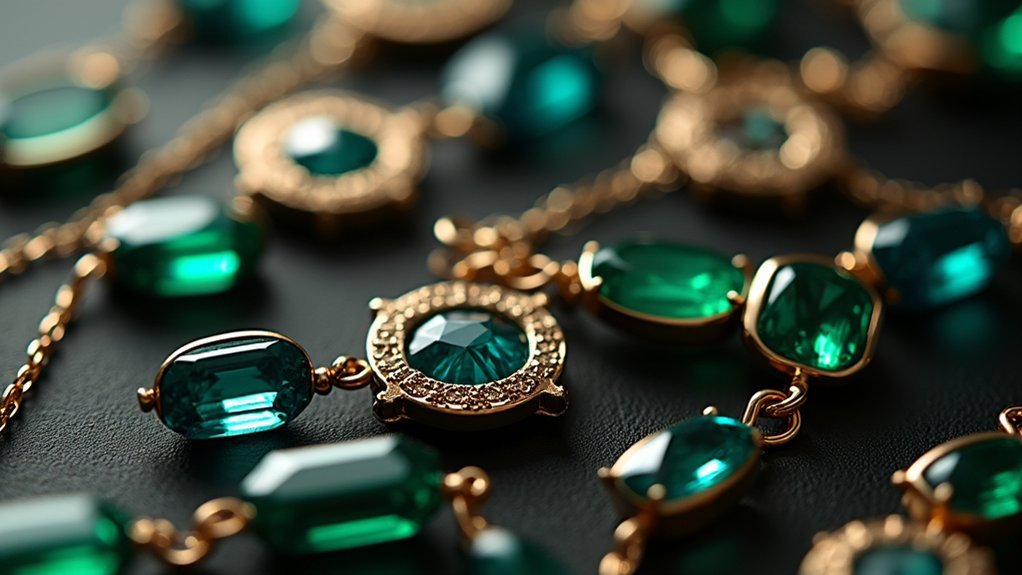



Leave a Reply